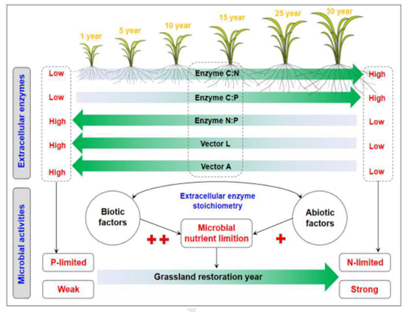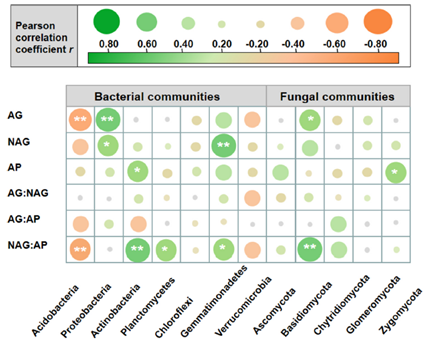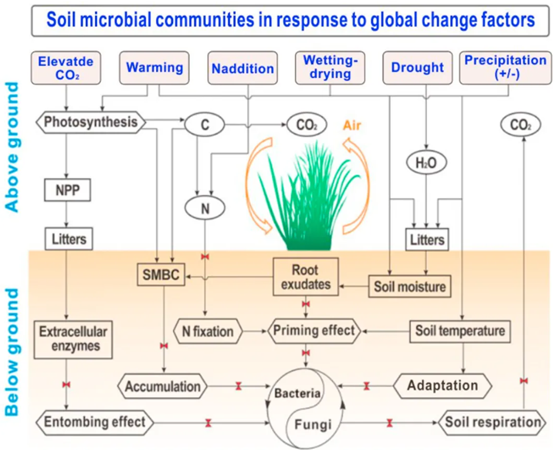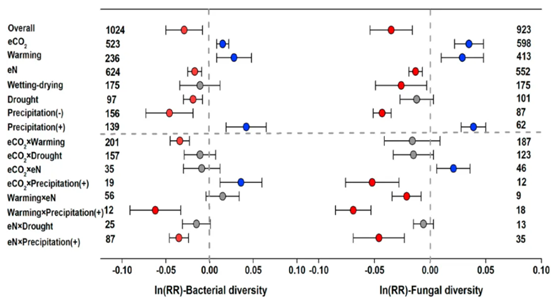Various of soil extracellular enzymes secreted by microorganisms can catalyze the decomposition of soil organic matter, and play an important role in regulating soil nutrient cycling in ecosystems. Soil extracellular enzyme stoichiometry (EES) and its ratio (EEA) reflect the availability of nutrients and the demand for resources of microorganisms.
Recently, a research group from Institute of Earth Environment of the Chinese Academy of Sciences established the links between soil microorganisms and extracellular enzymes involved in soil organic carbon cycling (Fig. 1), and then evaluated the microbial nutrition limitation of the different restoration year (1-, 5-, 10-, 15-, 25- and 30-year old sites).

Fig. 1 Expanded successional loop that links microbes, detrital organic matter, and ectoenzymes activities (Image by YANG, et)
The ratio of the natural logarithm of C-, N-, and P-acquiring enzymes ranged from 1:1.47:1.05 to 1:0.82:1.38, and the average was 1:1.08:1.28, indicating that microorganisms were co-limited by N and P. Enzyme N:P ratio increased and vector angles decreased with time since restoration, suggesting that the restored grassland shifted from P-limitation to N-limitation (Fig. 2; Yang, et al., SBB, 2020).

Fig. 2 A theoretical framework exploring the effects of grassland restoration on soil extracellular enzyme stoichiometry and the microbial nutrient limitation. (Image by YANG, et)
Ectoenzyme stoichiometry ratios were strongly related to the relative abundance of predominant fungal phylum (Ascomycota, Basidiomycota) and bacterial phylum (Acidobacteria), and ultimately leading to the microbial life history strategies transiting from the oligotrophic groups with retarded growth, to the copiotrophic groups with rapid growth. These differences of microbial community composition, driven by ectoenzyme stoichiometry ratios, reflect soil microbial nutrient cycling following the conversion of cropland into grassland (Yang, et al., AGEE, 2021).

Fig. 3 Pearson correlation analysis between the relative abundance of dominant soil microbial phyla (left columns, bacterial communities; right columns, fungal communities) and ectoenzyme stoichiometry during grassland restoration. (Image by YANG, et)
Also, they conducted a global meta-analysis based on data collected from 237 published papers to explore the effect of multiple global change factors (elevated carbon dioxide (eCO2), warming, elevated nitrogen addition (eN), wetting–drying cycle, drought, decreased precipitation (precipitation (-)), and increased precipitation (precipitation (+))) on microbial diversity across different ecosystems (Fig. 4, Yang, et al., SBB, 2021).
Global change decreased soil bacterial and fungal diversity by an average of 2.9% and 3.5%, respectively (Fig. 5). Microbial diversity was highly dependent on climate conditions at the global scale. In addition, two- and three-way interactions of global change factors aggravated the negative effects of individual effects.

Fig. 4 Conceptual model of the effect of global change factors on soil microbial communities, highlighting the microbial metabolic processes involved in carbon (C), nitrogen (N), and water (H2O) cycling in terrestrial ecosystems. (Image by YANG, et)

Fig. 5 The response of effect size (ln RR) of soil bacterial (left) and fungal (right) diversity to global change factors (elevated carbon dioxide (eCO2), warming, elevated nitrogen addition (eN), wetting–drying cycle, drought, precipitation(- ), and precipitation(+)), including two-way interactions between global change factors (eCO2 × warming, eCO2 × drought, eCO2 × eN, eCO2 × precipitation(+), warming × eN, warming × precipitation(+), eN × drought, and eN × precipitation (+)). (Image by YANG, et)
The studies, published in Soil Biology and Biochemistry and Agriculture, Ecosystems & Environment, were supported by the Strategic Priority Research Program of Chinese Academy of Sciences, the National Science Foundation of China, the State Key Laboratory of Loess and Quaternary Geology, Chinese Academy of Sciences, and the CAS “Light of West China” Program.
Contact: Bai Jie, Institute of Earth Environment, Chinese Academy of Sciences, Xi'an, China. Email: baijie@ieecas.cn
 © 2015 Institute of Earth Environment,CAS
© 2015 Institute of Earth Environment,CAS Address:No. 97 Yanxiang Road, Xi'an 710061, Shaanxi, China

 Location :
Location :